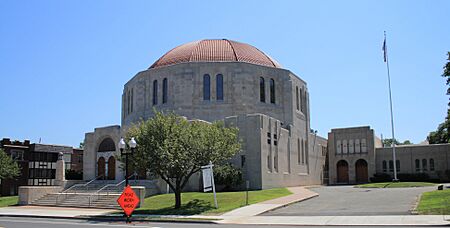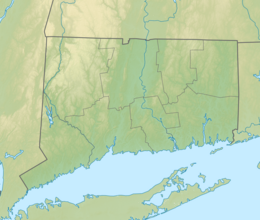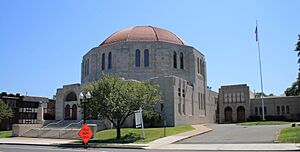Congregation Beth Israel (West Hartford, Connecticut) facts for kids
Quick facts for kids Temple Beth Israel |
|
|---|---|

The current synagogue in West Hartford, in 2008
|
|
| Religion | |
| Affiliation | Reform Judaism |
| Ecclesiastical or organisational status | Synagogue |
| Leadership |
|
| Status | Active |
| Location | |
| Location | 701 Farmington Avenue, West Hartford, Connecticut 06119 |
| Country | United States |
| Architecture | |
| Architect(s) |
|
| Architectural type | Synagogue |
| Architectural style | 1876:
|
| Date established | 1843 (as a congregation) |
| Completed |
|
| Dome(s) |
|
Congregation Beth Israel is a Jewish community and synagogue in West Hartford, Connecticut. Its name means "House of Israel" in Hebrew.
It started in 1843, making it one of the oldest Jewish groups in Connecticut. It's also one of the biggest Reform Jewish communities in New England. About 650 families and 2,000 people are members.
The first synagogue building for Congregation Beth Israel was finished in 1876. It was located on Charter Oak Avenue in Hartford. This building is now a cultural center. It was designed by George Keller in the Romanesque Revival style. It was added to the National Register of Historic Places in 1978.
Contents
History of Congregation Beth Israel
How the Congregation Started
Beth Israel was founded in 1843. This was the same year that Connecticut first allowed Jewish people to worship publicly. Another Jewish group, Congregation Mishkan Israel, also started that year.
Beth Israel began as an Orthodox congregation. However, it quickly adopted Reform practices. This change was partly because many German Jewish people moved to Hartford. In 1877, the congregation joined with other American Reform Jewish communities. They formed the Union of American Hebrew Congregations.
The First Synagogue Building
Congregation Beth Israel's first synagogue was built in 1876. It was located at 21 Charter Oak Avenue in Hartford. Beth Israel moved out of this building in 1936. Today, the building is home to the Charter Oak Cultural Center. It is one of the oldest synagogue buildings still standing in the United States.
Beth Israel moved to its current location in West Hartford in 1936.
Leaders of the Congregation
Rabbi Abraham J. Feldman
For much of the mid-1900s (from 1925 to 1977), Rabbi Abraham J. Feldman led Congregation Beth Israel. He was a major supporter of the Classical Reform way of thinking. One change Rabbi Feldman brought was the confirmation ceremony for 16-year-olds.
Dr. Feldman was a well-known Jewish leader across the country. He received many awards and wrote several books. He held important positions, including on the Connecticut Advisory Committee of the United States Commission on Civil Rights. President Dwight D. Eisenhower praised him for his "outstanding leadership."
Rabbi Harold Silver
Rabbi Harold Silver took over from Rabbi Feldman in 1968. He was the senior rabbi for 25 years, retiring in 1993. Rabbi Silver came from a family of rabbis. His father, Maxwell Silver, was a rabbi in New York City. His uncle, Abba Hillel Silver, was a rabbi in Cleveland, Ohio. His grandfather, Moses Silver, was a rabbi in Jerusalem.
Rabbi Silver was ordained in 1951 at Hebrew Union College in New York City. He first served as an assistant rabbi in Pittsburgh. Later, he became a rabbi at Temple Emanuel in Pittsburgh. He served there from 1955 until 1968, when he came to Congregation Beth Israel.
Silver was very important in the Hartford Jewish community. He helped create the first Greater Hartford Rabbinical Board of Rabbis. This group brings together rabbis from different Jewish congregations. He also served on many community boards, both Jewish and non-Jewish.
Rabbi Silver also encouraged different faiths to talk and understand each other. He preached at many local churches. He also taught classes about Judaism at local universities. In 1984, he hired Connecticut's first female associate rabbi, Jody Cohen, to work at Beth Israel.
Rabbi Silver retired in 1993 and became rabbi emeritus. He passed away on March 9, 2017, at 92 years old.
Rabbi Simeon Glaser
Rabbi Simeon Glaser followed Rabbi Silver in 1993. He had been an assistant rabbi at Beth Israel before becoming senior rabbi. Rabbi Glaser was popular with young families and children. This was because he loved and was talented at music and song.
Rabbi Glaser led lively services for holidays like Purim and Simchas Torah. During these services, he, Cantor Green, and Assistant Rabbi Weiss would sing, dance, and act out holiday stories. After four years as senior rabbi, Glaser left Beth Israel. He later served at Temple Israel in Minneapolis, Minnesota.
Welcoming New Immigrants
During the 1990s, Congregation Beth Israel played a big role in helping Jewish immigrants from the former Soviet Union. A group called the New American Committee was formed. It helped with education, finding jobs, getting clothes, and setting up homes.
The New American Committee still offers learning opportunities, including lectures and language classes. Today, Congregation Beth Israel has many Russian-speaking members. These immigrants make up a large part of the congregation.
Rabbi Stephen Fuchs
Rabbi Stephen Fuchs became the senior rabbi in 1997. He has served as Rabbi Emeritus since 2011.
Synagogue Architecture
The current synagogue building is very large. It has a big dome built in the Byzantine Revival style. The building has many different parts. These include a main worship area (the sanctuary), a smaller chapel, a religious school, a pre-school, offices, and meeting halls. It also has a small museum and a library. Both the sanctuary and the chapel have beautiful stained-glass windows.
The building was designed by Charles R. Greco in 1936. This was during the time of the Art Deco movement. The Byzantine Revival style combined with Art Deco gives the building a grand look. In 2006, the congregation received an award for carefully restoring this historic building.
The synagogue building was one of fifteen Connecticut synagogues added to the National Register of Historic Places in 1995 and 1996.
See also
- National Register of Historic Places listings in West Hartford, Connecticut
- Oldest synagogues in the United States



